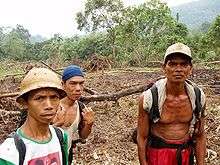Orang Pendek
Orang Pendek (Indonesian for "short person") is the most common name given to a cryptid, or cryptozoological animal, that reportedly inhabits remote, mountainous forests on the island of Sumatra. The animal has allegedly been seen and documented for at least one hundred years by forest tribes, local villagers, Dutch colonists and Western scientists and travellers. Consensus among witnesses is that the animal is a ground-dwelling, bipedal primate that is covered in short fur and stands between 80 and 150 cm (30 and 60 in) tall.[1][2]
 Artist's impression of the Orang Pendek | |
| Grouping | Cryptid |
|---|---|
| Sub grouping | Hominid |
| Other name(s) | Short Person (translation) |
| Country | Indonesia |
| Region | Sumatra |
Location

While Orang Pendek or similar animals have historically been reported throughout Sumatra in Indonesia, and Southeast Asia, recent sightings have occurred largely within the Kerinci Regency of central Sumatra and especially within the borders of Taman Nasional Kerinci Seblat (Kerinci Seblat National Park) (TNKS).[3] The park, 2° south of the equator, is located within the Bukit Barisan mountain range and features some of the most remote primary rainforest in the world. Habitat types within the park include lowland dipterocarp rainforest, montane forests, and volcanic alpine formations on Mt. Kerinci, the second highest peak in Indonesia.[3] Because of its inaccessibility, the park has been largely spared from the rampant logging occurring throughout Sumatra and provides one of the last homes for the endangered Sumatran tiger.
Description
Orang Pendek has yet to be fully documented and no authoritative account of its behavior or physical characteristics exists. However, witnesses report some characteristics consistently, so a likely picture of the animal can be conjectured.
Attributes
Other reports
- blackish-brown, red-brown, golden-brown, yellow, or orange fur
- short-legged with long, powerful arms
- seen in trees[1]
Reported dietary habits
Sightings by locals often take place in farmland on the edge of the forest, where Orang Pendek is allegedly seen walking through fields and raiding crops (especially corn, potatoes, and fruit). Locals with experience in the forests claim that Orang Pendek seeks out ginger roots,[4] a plant known locally as "pahur" or "lolo", young shoots, insects in rotting logs, and river crabs.
Names
Orang Pendek and similar cryptids from this area of the world are also referred to as Uhang Pandak (local Kerinci dialect), Sedapa, Ebu Gogo, Umang, Orang Gugu,[2] Orang Letjo, Atoe Pandak, Atoe Rimbo, Ijaoe, Sedabo, and Goegoeh.
Sources
Witnesses from many different backgrounds have reported seeing Orang Pendek over the last hundred years.
John of Marignolli
John of Marignolli (1338–53) was one of earliest persons to mention the existence of hairy humanoid in Southeast Asia. When he visited the Kingdom of Saba (which could be interpreted as Java or Sumatra), he seldom caught sight of wild men, naked and hairy, abiding in the woods, who would flee into the forest when they perceive anyone coming. They did a great deal of work, sowing and reaping corn and other things, and people may trade with them by putting items in the middle of a path. Then the purchasers go forward and deposit the price, and take what has been set down. This description, however, may refer to more humanlike cryptid from the region, like the Siwil. John concludes that:[5]
"...these monsters are not men, although they may seem to have some of the properties of men, but are merely of the character of apes; (indeed if we had never seen apes before we should be apt to look upon them as men!); unless forsooth they be monsters such as I have been speaking of before, which come of Adam's race indeed, but are exceptional and unusual births."
— Giovanni de' Marignolli
Suku Anak Dalam
The Suku Anak Dalam ("Children of the Inner-forest") – also known as Orang Kubu, Orang Batin Simbilan, or Orang Rimba—are groups of nomadic people who have traditionally lived throughout the lowland forests of Jambi and South Sumatra. According to their legends, Orang Pendek has been a part of their world and a co-inhabitant of the forest for centuries. Benedict Allen, author of Hunting the Gugu, writes that these groups frequently leave offerings of tobacco to keep the Orang Pendek happy.[2]
In Bukit Duabelas, the Orang Rimba speak of a creature, known as Hantu Pendek (short ghost), whose description closely matches that of Orang Pendek. However, Hantu Pendek is thought of as a ghost or demon rather than an animal.[6] According to the Orang Rimba, the Hantu Pendek travel in groups of five or six, subsisting off wild yams and hunting animals with small axes. Accounts of the creature claim it ambushes unfortunate Orang Rimba hunters traveling alone in the forest. Along the Makekal River on the western edge of Bukit Duabelas, people recount a legend of how their ancestors outsmarted these cunning yet dim-witted creatures during a hunting trip. The legend is often used to boast of the intellect and reason of people who live along the Makekal.
Dutch colonists
Dutch settlers in the early 20th century provided Westerners with their modern introduction to Orang Pendek-like animals in Sumatra. Two accounts in particular are widely reported:
- Mr. van Heerwarden, who described an encounter he had while surveying land in 1923:
I discovered a dark and hairy creature on a branch... The sedapa was also hairy on the front of its body; the colour there was a little lighter than on the back. The very dark hair on its head fell to just below the shoulder-blades or even almost to the waist... Had it been standing, its arms would have reached to a little above its knees; they were therefore long, but its legs seemed to me rather short. I did not see its feet, but I did see some toes which were shaped in a very normal manner... There was nothing repulsive or ugly about its face, nor was it at all apelike.[1]
Possible explanations
Three possible explanations of Orang Pendek's identity are prominent: that all sightings can be explained as the mistaken identification of local animals; that witnesses of Orang Pendek are describing a previously undocumented species of primate; and that a species of early hominin still lives in the Sumatran jungle.
Surviving hominin
As far back as Mr. van Heerwarden's account of Orang Pendek, people have speculated that the animal may in fact be a hominin.[1] In October 2004, scientists published claims of the discovery of skeletal remains of a new species of human (Homo floresiensis) in caves on Flores (another island in the Indonesian archipelago) dating from perhaps as recently as 12,000 years ago (later revised to 50,000 years ago). The species was described as being roughly one meter tall. The recency of Homo floresiensis' continued existence and the similarities between its physical description and the accounts of Orang Pendek have led to renewed speculation in this respect.
See also
- Bukit Timah Monkey Man – forest-dwelling cryptid linked to Orang Pendek
- Yeren
- Almas (cryptozoology)
- Bigfoot
- Yeti
- Orang Mawas
References
- Smith, Charles A. (1924-11-09). "Reported Find of Missing Link Will Be Probed". Nevada State Journal.
- Allen, Benedict (2002). Hunting the Gugu. Faber and Faber.
- "Kerinci Seblat National Park". Kerinci Seblat National Park. 2004. Retrieved 2005-08-17.
- Hellen, Nicholas and Jonathan Leake (1997-10-12). "The orange ape that walks like a man". The Sunday Times. Archived from the original on 2005-04-14. Retrieved 2005-05-30.
- Yule, Sir Henry (1913). Cathay and the way thither: being a collection of medieval notices of China vol. III. London: The Hakluyt Society.
- Sager, Steven (2008). The Sky is our Roof, the Earth our Floor: Orang Rimba Customs and Religion in the Bukit Duabelas Region of Jambi, Sumatra
- Adam Davies (2014). Manbests: A Personal Investigation (Chapters 4 and 7–9). CFZ Press. ISBN 978-1-909488-21-2.
- Rupert Matthews (2014) [2008]. Sasquatch: North America's Enduring Mystery; Kindle locations 2290–2400, 2594–2606. Arcturus Publishing. ISBN 978-1-78404-107-6.
External links
Investigations
- National Geographic expedition to camera-trap for Orang Pendek, July 2006
- "Short Man of the Forest: The Search for Orang Pendek" from the Banyak Films, June 2006
- Guardian Science Notes September 2011
General Information
- Sultan and the Mermaid Queen. Paul Spencer Sochaczewski. Editions Didier Millet. 2008. ISBN 978-981-4217-74-3. Includes several chapters on orang pendek, ebu gogo, sedapa and other “snowmen of the jungle.”
- Dunning, Brian. "Skeptoid #77: Orang Pendek: Forest Hobbit of Sumatra". Skeptoid.
Related
- Bipedalism in orangutans, from August 2007 issue of Scientific American